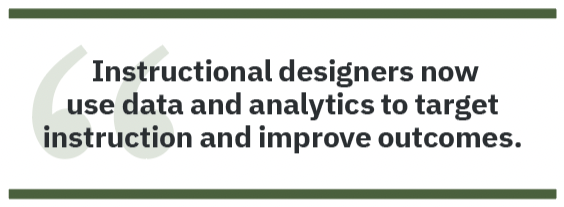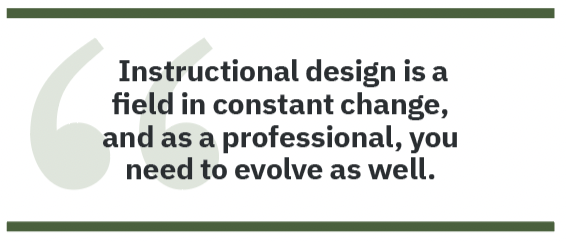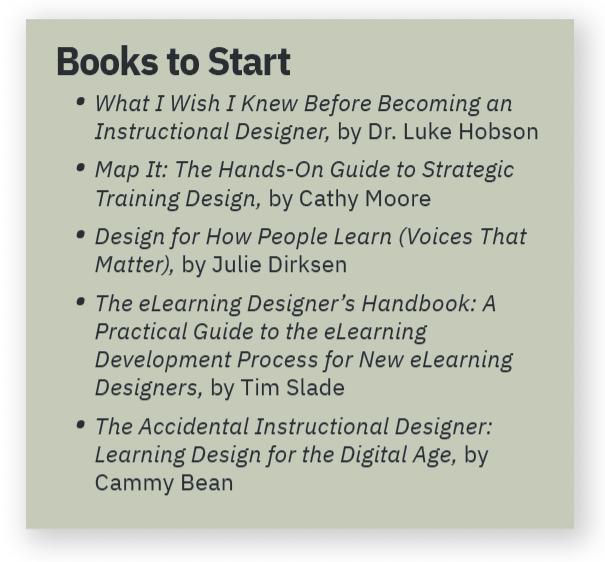By Edel Pace | STC Student Member
A wide range of knowledge is needed to begin or transition to a career
in instructional design, one of the fastest-growing professions.
The field of instructional design is rewarding if you have a passion for producing content for learners to succeed. Instructional design is the art of designing and iterating learning experiences and curricula to meet the learner’s needs.
An instructional designer can work in an academic setting developing courses or developing product- or service-specific training material in a business setting. To successfully start in or transition to instructional design, you first need to understand:
- the field’s history
- what the job entails
- the actions you can take to succeed in this journey
This article can help you get started or provide a refresher for those who already work in the field.
History of Instructional Design
Instructional Design is a relatively young field, starting in the 1940s during World War II when psychologists and educators joined forces to create training material for soldiers. In the 1950s, B.F. Skinner introduced “operant conditioning,” where instruction featured small steps and instant feedback, while Benjamin Bloom identified domains of learning, now known as Bloom’s Taxonomy.
During the 1960s, Robert Gagné introduced “The Conditions of Learning,” where he classified three domains of learning, five learning outcomes, and nine events of instruction in research, all of which are at the center of today’s instructional design.
As the role of computers evolved through the 1970s and 1980s, so too did the development of information processing systems. The 1970s saw the introduction of media in instruction and the development of information processing systems.
The 1990s saw significant developments in the field with the surge of the constructivist theory. Performance and prototyping (rapid development of instructional materials with even quicker iterations) became trends. Practitioners began to develop computer-based training (CBT) for interactive training.
The 2000s established e-Learning, especially in the private sector, mainly for onboarding practices. Learning Management Systems (LMSs) and Learning Management Information Systems (LMISs) rose in importance when the need to stay organized and capitalize on reusable material became apparent.
 From 2010 to today, online and hybrid learning became mainstream in academia and the corporate world, facilitated by widespread technology. The learner experience emerged as the central focus of the field with personalized instruction, and instructional designers now use data and analytics to target instruction and improve outcomes.
From 2010 to today, online and hybrid learning became mainstream in academia and the corporate world, facilitated by widespread technology. The learner experience emerged as the central focus of the field with personalized instruction, and instructional designers now use data and analytics to target instruction and improve outcomes.
Facts about instructional design
According to the Bureau of Labor Statistics, Instructional Design is one of the fastest-growing professions, with a projected 10 percent growth between 2020-2030, where the average is 8 percent.
The field of instructional design presents various career directions or specialized niches. For example, learning design or strategy, content writing, instructional technology, e-learning development, multimedia specialist, graphic and UI/UX design, instructor training, and project management.
Instructional designers report high satisfaction with their work–life balance. According to the 2021 Instructional Design Survey by Devlin Peck, 61 percent of the surveyed responded as very satisfied, and only 6 percent were not satisfied.
The average salary is ~$64K a year, according to Payscale. However, it is far less than what Peck reported in his survey, where the average compensation for a full-time employee is ~$85K a year.
What Do Instructional Designers Do?
Instructional designers need to master many skills to:
- Understand their audience
- Create engaging learning experiences
- Develop instructional roadmaps
- Evaluate results
- Iterate their materials to improve student success
We devise both courses and supporting materials while staying on top of current education and technology trends. Instructional designers work in the corporate world, for governments, academic institutions, non-profits, and as freelancers, consultants, or vendors.
Debate exists about whether a degree is needed to break into instructional design, and an individual’s circumstances and background might determine that answer. If “the proof of the pudding is in the eating,” having an exceptional portfolio of past projects could make up for a lack of formal education.
Instructional design theory
These are a range of theories, principles, and frameworks that an instructional designer should know:
- ADDIE stands for Analysis, Design, Development, Implementation, and Evaluation.
- Merrill’s Principles of Instruction has four stages: demonstration, activation, application, and integration. Some IDs add a fifth stage, engagement.
- Bloom’s Taxonomy has six main categories: knowledge, comprehension, application, analysis, synthesis, and evaluation.
- Gagné’s Events of Instruction comprises nine conditions for learning: gaining attention, informing objectives, stimulating prior information, presenting content, providing guidance, performance (application), providing feedback, assessment, and transfer.
- Action Mapping is used in the business world. Its four steps are to identify business goals, identify what people need to do, design practice activities, and identify what people NEED to know.
- ARCS Model of Motivation was developed by John Keller with four components: Attention, Relevance, Confidence, and Satisfaction (ARCS).
- Behaviorism guides learners to reach pre-established learning outcomes. One prevalent concept is operant conditioning, developed by B. F. Skinner.
- Cognitive Information Processing is a psychological approach to information processing, and it focuses on how people attend, encode, store, and retrieve information.
- Kirkpatrick’s Model of Evaluation outlines the levels at which an ID should evaluate outcomes: reaction, learning, behavior, and results.
- Mayer developed 12 guidelines in his Principles of Multimedia Learning, composed of these principles: coherence, signaling, redundancy, spatial contiguity, temporal contiguity, segmenting, pre-training, modality, multimedia, personalization, voice, and image.
- SAM (Successive Approximation Model) was developed by Michael Allen as a simplified version of the ADDIE model. His model has three phases: preparation, iterative design, and iterative development.
- AgileISD, developed by Conrad Gottfredson, introduced an Agile iterative approach into instructional design. AgileISD has five “moments:” align, get set, iterate and implement, leverage, and evaluate.
Technical skills
Keeping up with technological changes and advances is essential for an instructional designer. Depending on your niche, you might need to learn 1 or more of these tools used in daily activities:
- Authoring tools: Software that helps instructional designers create interactive content, for example, Articulate Storyline, Articulate Rise 360, Madcap Mimic, and Adobe Captivate.
- Web programming languages: HTML5, Cascading Style Sheets (CSS), and JavaScript.
- Learning Management Systems (LMSs): software or platforms used to deliver, track, and evaluate e-learning courses. Some well-known platforms are Adobe Captivate Prime, TalentLMS, Docebo, Articulate 360, Moodle, Canvas, EduMe, among many others.
- Instructional designers should know about the 2 primary standards to deploy the LMS: Shareable Content Object Reference Model (SCORM) and Experience Application Programming Interface (xAPI, also known as Tin Can API).
- Multimedia: TechSmith Camtasia, TechSmith Snag-It, Madcap Capture, Adobe XD, Adobe Illustrator (Creative Cloud).
Visual design knowledge
Instructional designers need to know about design and its application in an educational setting to help present content efficiently. Having web, graphic, or multimedia design skills can set instructional designers apart when building digital materials to complement instruction. A good place to start is learning about the seven principles of design: emphasis, balance and alignment, contrast, repetition, proportion, movement, and white space.
To Succeed as an Instructional Designer
“Passionate” is a word many researchers use to describe instructional designers. If you have a passion for making a difference in someone’s life, advocating for learners, love collaborative roles, and continuous learning, you have found the right field to put your expertise and skills to work.
Instructional design is a field in constant change, and as a professional, you need to evolve as well. Attributes you can seek to improve might include:
- Learning from your experience
- Empathizing with learners and understanding the needs of your key stakeholders (those who create the learning needs)
- Listening actively
- Storytelling
- Improving your technological competence
- Developing your visual design skills
- Strengthening your imagination and ability to think creatively
Portfolio/experience
 Instructional designers, especially beginners or transitioning, should create a portfolio to showcase their abilities and understanding of the field. Having a portfolio is crucial if you have no experience.
Instructional designers, especially beginners or transitioning, should create a portfolio to showcase their abilities and understanding of the field. Having a portfolio is crucial if you have no experience.
A portfolio should include:
- Information about you and your background including education related to ID
- A résumé of past jobs held (even if they are not ID-related)
- Projects: Include projects that reflect where you’d like to specialize. Include notes to explain your process. These do not need to be paid projects. Remember, prospective employers are concerned with how successful the training was and if it was received well. If you can include metrics that “prove” your training works, so much the better.
How to gain experience
After you have learned and dived into the instructional design field, you need to build your network.
Excellent ways to network and gain experience include:
- Joining professional associations such as STC (especially the Instructional Design & Learning SIG), ATD, eLearning Guild.
- Attending training Industry conferences, seminars, webinars, and events, including those hosted by STC, ATD, and Training Magazine.
- Using social media, such as LinkedIn and Twitter — specially to follow industry notables and keeping up with trends and industry thinkers.
- Joining online communities: STC, Devlin Peck, Tim Slade, Cara North, among others.
- Volunteering. Beyond the STC’s special interest groups, many organizations and charities in your town or city would probably welcome a volunteer who could:
- Create an effective onboarding package
- Codify and improve their current training methods
- Prepare and deliver a PowerPoint presentation on (for instance) safety practices or store opening/closing procedures
Search for instructional design job descriptions specific to the ID aspect that calls to you and see how your skills fit. Use LinkedIn for this purpose. Polish those skills and don’t be afraid to apply for jobs even if you don’t meet all the requirements — yet. Instructional design jobs are not static, and there is room for growth with your company or as a freelancer. Staying current with changes is essential; dare to explore new resources and apply them to your work.
Remember, instructional design is not a one-size-fits-all kind of field. I wish you much success in becoming an instructional designer.

EDEL PACE (epacestudio@gmail.com), a senior at the University of Memphis studying professional writing and creative mass media and a participant of the Accelerated Bachelor to Master’s (ABM) program. She is a student member of the STC and a volunteer in the Instructional Design & Learning (IDL) SIG. Edel is also a founding member and first officer of the Writing, Rhetoric, and Technical Communication (WRTC) Club, a registered student organization at the University of Memphis. She loves reading, drinking coffee, and having fun with her kids.




